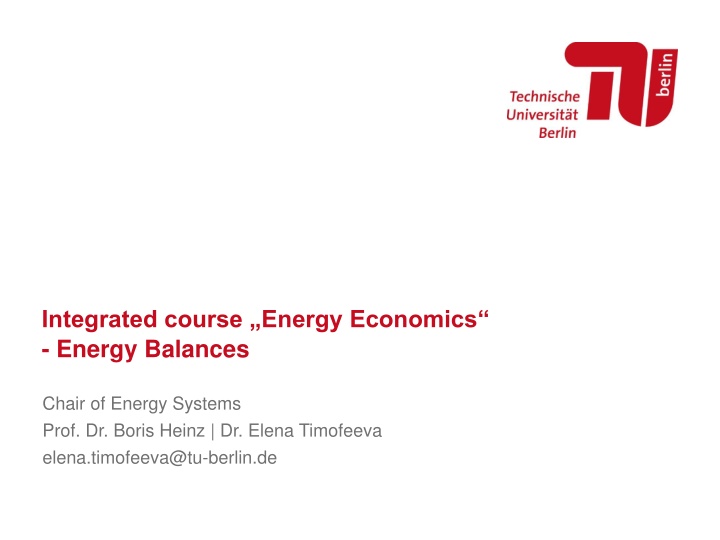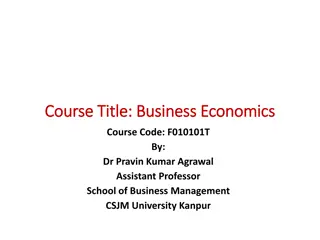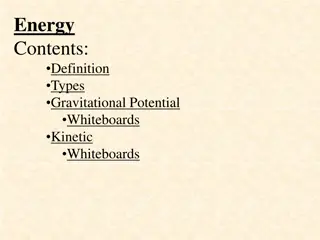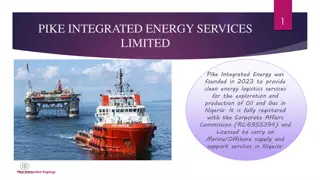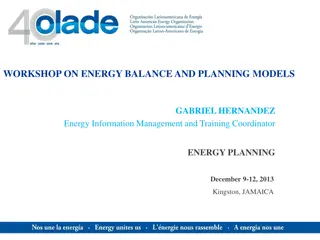Integrated course „Energy Economics“
Energy economics is the study of production, distribution, and consumption of goods and services, focusing on energy balances, primary and secondary energy sources, measuring primary energy, lower calorific value, and units of energy. Explore the concepts and data sources in energy statistics.
Download Presentation

Please find below an Image/Link to download the presentation.
The content on the website is provided AS IS for your information and personal use only. It may not be sold, licensed, or shared on other websites without obtaining consent from the author.If you encounter any issues during the download, it is possible that the publisher has removed the file from their server.
You are allowed to download the files provided on this website for personal or commercial use, subject to the condition that they are used lawfully. All files are the property of their respective owners.
The content on the website is provided AS IS for your information and personal use only. It may not be sold, licensed, or shared on other websites without obtaining consent from the author.
E N D
Presentation Transcript
Integrated course Energy Economics - Energy Balances Chair of Energy Systems Prof. Dr. Boris Heinz | Dr. Elena Timofeeva elena.timofeeva@tu-berlin.de
Outline Introduction Energy balances Data sources Explore energy statistics in groups Seite 2
Introduction: Energy economics Economics is a social science studying production, distribution and consumption of goods and services. Economics deals with allocation of scarce resources. Energy is abundant in the nature but mostly not immediately applicable for doing useful work. Engineering know-how + Economic viability Seite 3
Energy Balances: Energy sources Primary energy sources are in the form as found in nature and have not undergone any transformation. oil, coal, natural gas, nuclear, wind, solar, biomass, geothermal, hydropower Secondary energy sources are forms of energy after conversion, either chemical or physical. electricity, refined fuels (e.g. gasoline), synthetic fuels (e.g. hydrogen) easily usable form Seite 4
Energy Balances: Energy flow chart Source: Zweifel / Praktiknjo / Erdmann, 2017 Seite 5
Energy Balances: Measuring primary energy Primary energy sources are originally measured in units corresponding to their natural form: volume, mass etc. Original units can be converted into energy units. Calorific value is used for energy sources that can be converted into heat through combustion: coal, gas, oil, biomass. @ Ensys Seite 6
Energy Balances: Lower calorific value of energy fuels @ Prof. Dr. Georg Erdmann Seite 7
Energy Balances: Units of energy Source: Zweifel / Praktiknjo / Erdmann, 2017 Tonne of oil equivalent (t.o.e.): energy generated by burning one metric ton (7,4 barrels) of oil, or 1270 m3of natural gas, or 1,4 metric tons of coal. Seite 8
Energy Balances: Measuring RES How to value energy carriers which do not have a calorific value, e.g. wind, PV, nuclear energy, electricity imports, water, geothermal heat? Substitution Principle: amount of fuel that would be necessary to produce that amount of electricity in a thermal powerplant (35-40%) Efficiency Principle: actual efficiency of respective technology (hydro 80-90%, wind 30-55%, solar 10-25%) Fictive Efficiency Principle (IEA): 100% for wind, solar, hydro (underestimated RES share) Seite 9
Energy Balances: Energy flow chart for Germany in 2018 Petajoule (PJ) Source: AGEB, 2019 Seite 10
Energy Balance: Simplified structure Source: Eurostat + Industry + Transport + Other sectors Seite 11
Energy Balance: Cumulated energy requirement Cumulated energy requirement is total primary energy amount required for production, use and disposal of a product over its lifetime. CER = CERP + CERU + CERD CER is used in life-cycle assessment to account for all environmental impacts of an industrial process. 'Grey energy Energy required for production/recycling is not reflected in the national energy balances in this case. Seite 12
Data sources: Energy statistics online IEA BP Review U.S. Energy Information Administration Eurostat ENTSO-E, ENTSO-G EEX AGEB BNetzA BMWi Seite 13
Data sources: IEA International Energy Agency (IEA) is an automonous intergovernmental organisation providing authoritative analysis on global energy topics (publications, data and statistics, trainings). OECD member countries (30 out of 36) IEA World Energy Outlook IEA Market Reports Key World Energy Statistics https://www.iea.org/statistics/ Seite 14
Data Sources: BP Review of World Energy British Petroleum is a multinational oil and gas company. BP Energy Outlook BP Statistical Review of World Energy https://www.bp.com/en/global/corporate/energy-economics.html Seite 15
Data Sources: U.S. EIA U.S. Energy Information Administration (EIA) is a federal agency responsible for energy statistics and analysis (part of the U.S. Federal Statistical System). www.eia.gov International Energy Statistics Seite 16
Data Sources: Eurostat Eurostat is a division of European Commission tasked with providing statistical information to the institutions of the European Union and with promoting harmonisation of statistics across EU member states. https://ec.europa.eu/eurostat/web/energy/data/energy-balances Seite 17
Data Sources: ENTSO-E European Network of Transmission System Operators for Electricity (ENTSO-E) is an association of 43 electricity TSOs from 36 countries across Europe. Policy positions Technical cooperation among TSOs, network codes Long-term pan-European network development plan Reports on system adequacy Research coordination ENTSO-E Transparency Platform pan-European generation, transportation and consumption data https://transparency.entsoe.eu/ Seite 18
Data Sources: ENTSO-G European Network of Transmission System Operators for Gas (ENTSO-G) is an association of 44 electricity TSOs (+3 associated partners and 8 observers). Policy positions Technical cooperation among TSOs, network codes Long-term development plan for European gas infrastructure Reports on security of supply ENTSO-G Transparency https://transparency.entsog.eu/ Seite 19
Data Sources: EEX European Energy Exchange (EEX) in Leipzig is an exchange for energy and energy-related products. electricity, gas, coal, crude oil, CO2 emission certificates etc. EEX, EPEX SPOT, PEGAS/Powernext www.eex.com > Market Data Seite 20
Data Sources: AG Energiebilanzen (AGEB) Working Group on Energy Balances (Energy Balances Group) German association tasked with scientific analysis of energy statistics (four federations of the energy industry and five research institutions). Compiles yearly energy balances of Germany www.ag-energiebilanzen.de Seite 21
Data Sources: BNetzA Federal Network Agency (BNetzA) is a German agency tasked with regulation in the electricity, gas, telecommunication, post and railway sectors. SMARD information platform electricity generation, consumption, wholesale prices, imports/exports, system stability www.smard.de BNetzA Monitoring reports - key findings in English https://www.bundesnetzagentur.de/EN/Areas/Energy/Companies/ DataCollection_Monitoring/DataCollectionMonitoring_node.html Seite 22
Data Sources: BMWi German Federal Ministry of Economics and Energy (BMWi) Energy Data: Complete Edition Compilation of data from various sources https://www.bmwi.de/Redaktion/EN/Artikel/Energy/energy- data.html Seite 23
Question 1: Total Primary Energy Supply (TPES) What are the three countries with the highest TPES per capita ratio according to IEA? Discuss similarities and differences in these countries energy flows. Consult IEA Atlas of Energy Seite 25
Question 2: RES in German energy balance How much electricity was generated in Germany in 2017 (in GWh) and what was the share of renewables? Compare your result to the RES share according to IEA. Explain the discrepancy. Consult energy balances by AGEB Seite 26
Question 3: Energy mix How has the energy mix in the Asia Pacific region developed since 2010? Compare trends in China, India and the rest of the region. Consult BP Review Seite 27
Question 4: Electricity price (wholesale) Track the development of electricity price in Germany in the last ten years. Discuss possible price drivers. Seite 28
Question 5: Solar and base peak spread How has the share of solar generation in the German energy mix developed since 2012? What is the impact of the rising PV share on the electricity price? Seite 29
Question 6: System services How have the costs for system services in Germany developed over the last years? Compare the structure of these costs over time. Consult Monitoring reports by BNetzA Seite 30
Question 7: Retail Electricity Price How has the structure of electricity prices for final consumers changed since 2012? Discuss trends in the price structure. Consult Monitoring reports by BNetzA Seite 31
Question 8: Grid losses Please compare grid losses worldwide. What causes grid losses? Discuss their economic, environmental and social impacts. Consult information by the World Bank Seite 32
Question 9: Weather What was the weather like in Germany in summer 2018? Compare with historical data (temperature and percipitation). Show and explain the impact of the weather on the electricity price. Seite 33
Question 10: Road transport TPEC What is the share of road transport in the total primary energy consumption in Germany in 2007 and in 2017, respectively? How has the share of each primary energy source developed? Discuss possible reasons. Consult German energy balances by AGEB. Seite 34
Question 11: Cost of battery storage Show the development of cost for lithium-ion batteries (in /kWh). Discuss cost drivers and outlook. Seite 35
Question 12: Economics of hydrogen What are the technology options for producing hydrogen? Discuss the economics of these options. Staffell et al, The role of hydrogen and fuel cells in the global energy system, Energy & Environmental Science, 2019,12, 463 Seite 36
Question 13: CO2certificate prices How has the price of European Emission Allowances (EUA) developed over the past ten years? Discuss the reasons for these developments. Seite 37
Question 14: Energy efficiency Compare the trends for the global energy demand and for the change in energy intensity (i. e. progress with energy efficiency). Seite 38
Group Work Please work in groups of 5 - 6 students Preparation until end of this class Questions and presentation template are on ISIS: '20191015 Data sources_and_Questions' Please state your data sources Presentations in the next class: 17.10.2019 5 minutes per group Seite 39
